Industry News
How to improve the design and reliability of dampers through testing data?
2025-09-26 ![]() 49
49
In modern structural engineering and mechanical equipment, dampers play a crucial role in vibration reduction and energy dissipation. The design and reliability of dampers are directly related to the safety and operational stability of the overall system, whether it is bridges, super high-rise buildings, or large mechanical equipment. Traditional design often relies on theoretical models and empirical parameters, but nowadays, with the advancement of testing technology and data analysis methods, using test data to guide design in reverse has become a key path to improve the performance and reliability of dampers.

1、 The value of test data in damper design
Revealing the real working conditions
Theoretical models are usually idealized, while test data can truly reflect the response characteristics of dampers under different loads, frequencies, and temperatures, helping designers identify potential weak points.
Calibrate design parameters
By analyzing data such as force displacement curve, damping coefficient, hysteresis curve, etc., the rationality of the preliminary design can be verified, and parameter adjustments can be made to make it more in line with the actual usage environment.
Capture non-linear behavior
Dampers often exhibit nonlinear characteristics under large amplitudes or special conditions, and test data can provide quantitative basis for this behavior, thereby establishing design models more accurately.
2、 Data based design optimization methods
Multi condition dynamic testing
Dynamically test the damper at different frequencies, loads, and temperatures, collect a complete dataset, and form a multidimensional feature database to provide support for subsequent design.
Coupling between finite element model and test results
Combine test data with numerical simulation to form a closed-loop design process of "experiment simulation optimization". By adjusting material parameters, boundary conditions, and damping models, higher accuracy predictions can be achieved.
Sensitivity analysis driven by data
By utilizing statistical and machine learning techniques, sensitivity analysis is conducted on test data to identify key variables that affect performance, with a focus on optimizing these parameters in design.
3、 The key link to improving reliability
Fatigue and Life Assessment
Obtaining fatigue curves and life prediction data of dampers through long-term cyclic loading tests can help develop more scientific maintenance and replacement cycles.
Environmental adaptability verification
Conduct tests in environments such as high temperature, low temperature, humidity, and mixed vibration to evaluate the stability and repeatability of damper performance, and improve reliability in complex environments.
Failure Mode Identification
By using test data to identify potential failure modes such as cracks, wear, and loose connections in dampers, improvement measures can be taken in advance.
4、 Data Management and Intelligent Analysis
Modern damper testing has evolved from single point acquisition to multi-sensor synchronous acquisition, with a large amount of data and multiple dimensions. By establishing a data management platform and analysis model, it is possible to automate the processing of experimental data, extract key information, form a knowledge graph, and feed back into the design and development process.
5、 Industry Trends and Value
Design optimization and reliability improvement based on test data have become important trends in the damper industry. It can not only reduce the number of design iterations and trial production costs, but also provide quantitative basis for subsequent product standardization and quality management. For enterprises, the promotion of this approach means greater technological value and customer trust in market competition.

6、 Conclusion
Test data is not only the result of verifying the performance of dampers, but also the driving force for improving design and reliability. Through scientific collection, systematic analysis, and effective application of testing data, enterprises and research and development institutions can optimize damper design more efficiently, extend service life, and establish new quality benchmarks for the industry.